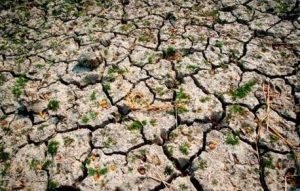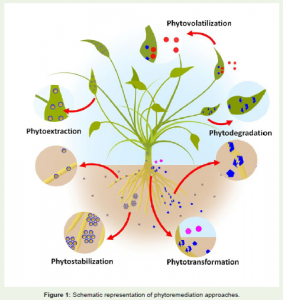Soil Salinity: The world population is going to reach 9.6 billion by 2050, the situation is alarming. This increase in population putting pressure on our natural resources. And to feed this population, there is need to increase the cultivated area or to increase the productivity of cultivated land.

The most critical threat to agricultural production is soil salinity. About 84800 million hectares of land is affected by varying level of salinity with 1-2% annual increase. There are various ways through which salinity negatively affect the soil physiochemical and biological properties. The crop loss is mainly due to interaction between soil salinity and soil moisture conditions.
The major effect of soil salinity is unavailability of water to plants due to blockage of soil pores. Normally, soil and ground water contain soluble salts. The increase in the level of salts in soil or water may affect the soil health which ultimately affect the plant growth and productivity. Soil Salinity is the increase in salt contents of soil to such an extent which affects agricultural production.
Types of Salt Affected Soils
Salt affected soils can be divided into three categories
- Saline Soil
- Sodic Soil
- Saline Sodic Soil
Classification of salt affected soils. | ||||
Salt affected soil classification | ph | Electrical conductivity (ds/m) | Sodium absorption ratio (SAR) | Soil physical conditions |
Saline | <8.5 | >4 | <13 | Normal |
Saline-Sodic | <8.5 | >4 | >13 | Normal |
Sodic | >8.5 | <4 | >13 | Poor |
Almost 40% of salt-affected soils in the world are saline wile 60% are sodic and saline sodic soils. Saline soils have large quantities of soluble salts while saline-sodic soils contain relatively high amount of exchangeable Na+ ions. Saline-sodic soils and sodic soils have same impermeable structure hence their remediation is also same. Sodic soils are further classified into sub categories; Alkali, Black-alkali and Slick-spot or solonetz soils.
Effect of soil salinity on soil health
Soil Salinity is the increase in salt contents of soil to such an extent which affects agricultural production.


Under normal conditions the presence of salts in the soil may improve its structure by flocculation and aeration and root development. However, high level of these salts may decrease the productivity of the soil. Soils with high Na+ may disperse more rapidly and ceases the air spaces between soils thus decrease the aeration of soil. Thus, the movement of water and air in the soil pores also decreases.
The decreasing infiltration rate tend to decrease the availability of water to the plants and plants may face restricted growth. Not all types of salts are harmful for the soil. Other salts such as Magnesium and Calcium improve the physical structure of the soil by enhancing soil particle flocculation and increasing the pores in the soil. It also increases the soil infiltration rate and porosity.
Effect of soil salinity on Plant Health
The concentration of salts may also increase the effect of other plant stresses like unavailability of water to the plants irrespective of the water contents of soil. In this condition, the soil water become unavailable to the plants due to high osmotic potential of roots. The water extraction from the soil become hard for plants. Thus, plants face severe shortage of water and the leaves may flaccid and wilting occurs. Different plant species behave differently under saline conditions.
Boyko (1966) was first to suggest the remediation of salt affected soils by halophytes. Since then several experiments have been conducted to reduce the effects of salt affected soils by using halophytes. Halophytology is a major concern for agricultural scientists due to its huge scope in reclamation as well as other productive benefits as oil seed crops and forages.
What is Green remediation?
Implementation of natural systems and processes to remove the soluble salts of the soil is called green remediation of salt affected soil. There are two types of green remediation;
Bioremediation
Use of microorganisms to remove or neutralize salts in the soil.
Phytoremediation
Use of plants to remove or neutralize the contaminants from the soil. Sesbania bispinosa, Suaeda maritime, and Sesuvium portulacastrum are some of the amazing salt tolerant plants.
There are following six mechanisms of phytoremediations through which inorganic and organic contaminants are taken up by plants and then sequestered and degraded.
- Phytostabilization
- Phytostimulation
- Phytoextraction
- Phytovolatilization
- Phytohydraulics
- Phytodegradation

Phytostabilization
Phytostabilization is also called phytosequesteration. In this process the organic and inorganic compounds in the soil are immobilized within the root zone through absorption, percolation or conversion to less harmful types. Carpobrutus rossii, an Australian native plant, have good potential of phytostabilization. Sometimes grasses and tress together provide efficient phytostabilization.
Phytostimulation
Phytostimulation or rhizodegradation is a process of enhancing the activity of microorganisms in rhizosphere with the vegetation to degrade the pollutants. Plants with heavy and dense root systems provide efficient niche to microbes. However, this process is more suitable where level of pollutant is very low so they are not toxic to selected species. The fungi Trichoderma sp. is an important plant in case of phytostimulation mechanisms.
Phytoextraction
In this mechanism the pollutants are up taken by roots and the movement of pollutants to above ground parts occur. It is known as phytoextraction. The main constraint in phytoextraction method is the length of time to achieve phytoremediation. Another concern is the feeding of animals to above ground parts of phytotoxic plants.
Phytovolatilization
The uptake and then translocation of pollutants after modifying and ultimate release to the environment through the process of transpiration is termed as phytovolatilization. Organic and inorganic pollutants are mainly used. Organic pollutants mainly require further degradation to further volatilization. This technique is used in Poplar sp. due to their high transpiration capacity.
Phytohydraulics
Phytohydraulics involves in uptake and degradation of water contaminants through their deep roots. Deep roots of different trees naturally pump water and provide a good source of phytoremediation to contaminated water and cleaning of root zone. Salix alba is used in the phytohydraulics activity.
Phytodegradation
Certain plants uptake and degrade the organic pollutants and inorganic nutrients into less harmful products with the help of enzymes. These plants have dense rooting systems. Plants with highly salt tolerance capacity such as Sarcobatus vermiculatus are used as phytodegredars.
Constraints of Green Remediation
Green remediation of salt affected soils is comparatively a low-cost solution and environmentally accepted. However, it requires some time to fully established as compare to Engineering based solutions due to following reasons
- There are major concerns of entering of toxic plants into animal feed or human food.
- The depth of the contamination is out of reach of plants. It is a major constraint in adaptability of phytoremediation processes.
- The variety of pollutants and their specificity is an important issue which require proper maintenance of the green remediation processes. Sometimes it will be impossible to control all the contaminants with one method so a precise remediation management strategy would be required to cope with the salt affected soils.
Conclusion
Green remediation is an environment friendly, inexpensive and efficient innovation to cope with the salt affected soils. Selection of appropriate species and proper management practices will further increase the efficiency of this system. Plant species with sufficient dense rooting system and greater biomass production will have more potential in the phytoremediation processes.
